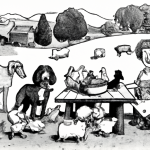Using Moon Phases for Planting
The Old-Time Wisdom of Moon Phases
The world around us is changing at an unprecedented pace. Natural disasters, economic instability, and political turmoil are becoming increasingly common. It’s a harsh reality, but one that we cannot ignore. As someone who is focused on self-reliance and preparedness, it’s important to equip ourselves with knowledge and skills to adapt to these uncertain times.
In our quest for self-sufficiency, we often turn to the wisdom of the past. One such piece of ancient knowledge is the practice of using moon phases to determine the optimal times for planting and growing our crops. While some may dismiss it as mere folklore or superstition, there is a surprising amount of scientific evidence that supports the effects of moon phases on plant growth.
The Science Behind the Practice
The gravitational pull of the moon affects Earth’s tides, which in turn influences the moisture content in the soil. Seeds absorb water to germinate and grow, and when the soil is at its most moist, it provides an ideal environment for this process. By aligning our planting schedule with the moon phases, we can take advantage of this natural phenomenon and give our plants the best chance of thriving.
The Best Times for Planting
1. **New Moon**: This is the ideal time for planting above-ground crops. The gravitational pull of the moon is at its strongest during the new moon phase, which means the moisture in the soil is also highest. Plant your leafy greens, fruits, and flowers during this time for optimal growth.
2. **First Quarter Moon**: This phase is perfect for planting crops that produce their yield above ground, such as beans and peppers. The waxing moon during this phase promotes leafy growth and ensures strong and healthy plants.
3. **Full Moon**: While it may be tempting to think that the full moon is the best time for planting, it’s actually a time for rest and reflection. Use this phase to assess the progress of your garden and tend to any maintenance tasks that need attention. Take a moment to appreciate the beauty of nature and recharge yourself for the next planting phase.
4. **Last Quarter Moon**: This phase is ideal for planting root crops and bulbs. The waning moon during this phase promotes strong root development, which is crucial for successful growth and harvest.
Final Thoughts
In a world that often seems unpredictable, it’s comforting to know that we can still rely on ancient wisdom to navigate our way through life. By aligning our planting schedule with the moon phases, we tap into a powerful force of nature and increase our chances of growing healthy and abundant crops.
While moon phase planting may not guarantee survival in the face of a major crisis, it is just one piece of the puzzle that contributes to our self-reliance and preparedness. As homesteaders and individuals striving for self-sufficiency, it’s crucial that we remain proactive and adaptable, constantly learning and applying new skills to enhance our resilience.
So why not give moon phase planting a try? Explore this ancient practice, experiment with your own garden, and observe the results. Embrace self-reliance, and let the moon be your guide as you cultivate your own path towards a more prepared and sustainable future.



GIPHY App Key not set. Please check settings